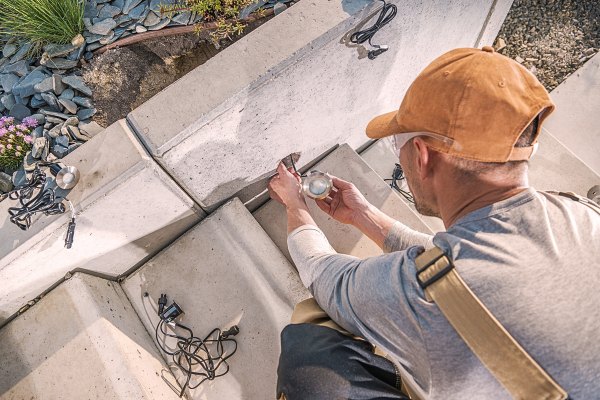Transforming your outdoor space with a concrete patio is a fantastic idea. But what if we told you that you could take it a step further? Imagine your patio adorned with beautiful LED landscape lights, creating a magical ambiance for your evening gatherings. Before you dive into pouring that concrete, though, it’s essential to lay the groundwork for a flawless LED landscape light installation.
This guide will walk you through the process in simple, easy-to-follow steps to ensure your patio shines both day and night.
Plan Your Lighting Design
Before you even think about concrete, take a moment to envision how you want your outdoor space to look and feel. Consider the areas you’d like to highlight, such as walkways, garden beds, or architectural features. Sketch a rough layout, keeping in mind the placement of electrical outlets. This step is crucial for determining the number and type of LED lights you’ll need.
Choose the Right LED Lights
Not all LED landscape lights are created equal so you need a professional landscape designer for proper guidance. Selecting the right fixtures for your patio is key to achieving the desired effect. Opt for weather-resistant lights designed for outdoor use. LED lights come in various colors, intensities, and styles, so choose ones that complement your overall design. Additionally, consider energy efficiency, as these lights are not only environmentally friendly but also cost-effective in the long run.
Plan the Wiring Layout
Once you’ve selected your LED lights, it’s time to plan the wiring layout. This step is crucial for ensuring a seamless installation. Determine the locations of your power source and outlets, keeping in mind the distances between lights. Consider burying the wiring underground for a cleaner look. Make a detailed plan to guide you during the installation process, preventing any last-minute adjustments that could disrupt your concrete pour.

Install Conduit for Wiring
To protect your wiring and make future maintenance easier, install a conduit before pouring the concrete. A conduit is a tubing system that encases the wires, shielding them from the elements. Lay the conduit along the planned wiring route, securing it in place. This step is essential for preventing accidental damage to the wiring during the concrete pour and makes it simpler to replace or upgrade your LED lights in the future.
Test Your Lights Before Concrete Pour
Before the concrete pour begins, take the time to test your LED lights. Connect the wiring to ensure all lights are functioning correctly. This step allows you to identify and address any issues before they become buried beneath the concrete. Testing beforehand can save you time, money, and headaches later on.
Conclusion
By taking these steps before pouring your concrete patio, you set the stage for a seamless LED landscape light installation. Planning your lighting design, choosing the right LED lights, mapping out the wiring, installing conduit, and testing your lights in advance will ensure a stunning and functional outdoor space. Now, as you move forward with your patio project, you can do so with confidence, knowing that your LED lights will illuminate your outdoor haven for years to come.
FAQs
Can I install LED landscape lights after pouring the concrete patio?
While it’s technically possible, it’s highly recommended to plan and install your LED landscape lights before pouring the concrete. This ensures a cleaner and more efficient installation, preventing the need for disruptive adjustments later on.
Why is conduit necessary for the wiring?
Conduit protects the wiring from damage during the concrete pour and makes future maintenance and upgrades easier. It’s a crucial step to ensure the longevity and functionality of your LED landscape lights.
Can I bury the wiring without a conduit?
While technically possible, burying wiring without conduit increases the risk of damage and makes future repairs or modifications challenging. Conduit provides a protective layer, safeguarding your wiring from the elements and potential disturbances.
Is testing the LED lights before the concrete pour really necessary?
Yes, testing your LED lights before the concrete pour is essential. It allows you to identify and address any issues, ensuring that your lights are in proper working order before they are permanently placed beneath the concrete.
